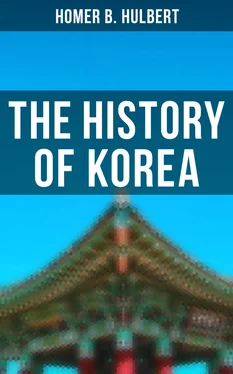Ka-rak extended eastward as far as Wang-san River, six miles to the west of the present Yang-san; to the north-east as far as Ka-ya San, the present Ko-ryŭng; to the south and south-west as far as the coast and on the west to Chi-ri San. From this we see that it was little inferior to Sil-la in size.
Ka-rak had five dependencies, namely the districts known under the common name of Ka-ya. They were So-ga-ya, Ko-ryŭng-ga-ya, Song-san-ga-ya, Tă-ga-ya and A-ra-ga-ya. They correspond respectively to the present towns of Ko-sŭng, Ham-ch’ang, Ham-ch’ang, Sŭng-ju, Ko-ryŭng andHam-an. Tradition says that one day when the chiefs of the nine tribes of Ka-rak were banqueting they saw upon the slope of Sung-bong, called also Ku-yii-bong, a singular cloud. From the sky above it came a voice. They hastened up the mountain and there found a golden box containing six golden eggs. These opened and disclosed six boys. One of them was Keum Su-rowho became king of Ka-rak and the other five were made chiefs of the five Ka-ya, subject to Ka-rak. Of these Ka-ya states we know the founder of only one. He was descended from Kyŏn-mo-ju, the female divinity of Ka-ya Mountain who wedded a celestial being, Yi-ja-ga. Their off-spring was Yi-i-a-si, who founded one of the Ka-ya states. The Ka-ya states fell before Sil-la some five hundred years later in the reign of King Chin-heung.
Vicissitudes of Ko-gu-ryu … last Ma-han chief joins Sil-la. … Pak-je and Sil-la become sworn enemies … legend of Kye-rim. … Pak-je worsted. … Ko-gu-ryu’s strength on the increase. … Sil-la’s rapid growth. … Ka-ya attacks Sil-la. … Ko-gu-ryu make compact with Ye-mak. … Su-sŭng’s evil reign … roads in Sil-la. … Japanese raid … legend … an epicurean. … Pak-je’s victory … origin of government loans. … Yun-u’s trickery … capital of Ko-gu-ryu moved … wild tribes attack Sil-la … democratic ideas in Sil-la. … Ko-gu-ryu breaks with China … and attacks Sil-la. … China invades Ko-gu-ryu … the king retreats … relieved through treachery … capital of Ko-gu-ryu moved to P’yung-yang … beginning of feud between Korea and Japan … reforms in Pak-je … third century closes … progress of Sil-la … how Eul-bul became king of Ko-gu-ryu … a noble lady of Sil-la issent to Japan.
Mu-hyŭl, the third king of Ko-gu-ryŭ died in 45, leaving the kingdom to the tender mercies of his son a worthless debauchee. Four years later he in turn made way for Hă-u, a member of a collateral branch of the family. Following the traditions ofKo-gu-ryŭ this ruler professed loyalty to China on the one hand and seizedall the Chinese territory he could lay hands on, on the other. In 54 he was assassinated by one Tu-no and the seven year old grandson of king Yu-ri was placed on the throne, a regent being appointed to carry on the government until the boy reached his majority. The good work continued. Ten forts were built in western Liao-tung to guard against Chinese advances, which shows that she had regained nearly all the territory she had lost at the hands of the parvenu Wang-mang. The following year she took formal possession of the territory of Ok-jŭ on the eastern coast.
In the year 58 Yu-ri, the third king of Sil-la died. He must not be confounded with Yu-ri the second king of Ko-gu-ryŭ. The sound is the same but the character is different. It was he who had the difference of opinion with Sŭk-t’al-hă in regard to the succession. As he died without issue the reins of government naturally passed into the hands of the aged statesman Sŭk-t’al-hă. He was sixty-two years old when he assumed the cares of royalty. In his fifth year the one remaining Ma-han chief, Măng-so, who had escaped the appetite of Păk-je, went over to Sil-la, as he concluded it was no longer possible to prolong a hopeless struggle againstPăk-je. Pok-am fortress thus passed into the hands of Sil-la. Strange to say Păk-je not only did not resent this but even made overtures to Sil-la for a friendly meeting of their respective kings in the following year. Sil-la refused to sanction this, and the rebuff was too much for the equanimity of Păk-je. From that day the attitude of Păk-je toward Sil-la was one of studied hostility, broken only by an occasional spasmodic attempt at reconciliation. Among the three kingdoms, Sil-la was the only one that preserved her dignity intact and kept herself untainted by the charge either of avarice or pusilanimity.
The year 66 brought forth another of those wonders that embellishthe legendary lore of Korea. The king of Sil-la was wakened one night by the loud cackling of a hen, which seemed to come from a forest to the south. A messenger was sent to see what was the cause of the disturbance and he found a box hanging from the branch of a tree, while on the ground beneath it there cluttered a white hen. When the box was placed before the king and he had opened it a handsome child was found. It received the name Keum Yun-ji. Some say this Yŭn-ji was merely a part of the name while others affirm that it is a pure Sil-la word meaning “baby”. Up to this time the kingdom had been called Sŭ-ra-bŭl but now the king changed it to Kye-rim, kye meaning “hen” and rim meaning “woods.” So the kingdom was called “Hen in the Woods”, not a very dignified name but one, perhaps, that fitted well the military prowess of the kingdom.
In 68 Păk-je deemed herself strong enough to undertake operations against Sil-la. She began by seizing the fortress of Wa-san. She enjoyed possession of it for nine years but in the end she paid dear, for it was retaken by Sil-la and the Păk-je garrison was put to the sword. This year also saw a continuation of Ko-gu-ryŭ’s forward policy and the little settlement of Kal-sa which had been make by Pu-yŭ fugitives was absorbed. She followed this up by the conquest of Chu-ra farther north. Her military strength seems to have been on the rapid increase.
In 80 the great Sŭk-t’al-hă died and was succeeded by the son of King Nam-hă. He must have been of advanced age and yet not so old as to prevent his becoming the greatest conqueror that Sil-la ever produced. During the thirty-two years of his reign he added to the Sil-la crown the districts of Eum-jip-pŭl, Ap-to, Pi-ji, Ta-bŭl, Ch’o-p’al, and Sil-jik. These together with U-si and Kŭ-ch’il, which and been added the year before his accession, formed a considerable increase in the territory of the kingdom and added not a little to Sil-la’s reputation as a military power. This king, P’a-sa, was one of those men who seem to take hold of affairs by the right end and wring success from seeming failure. He was as great an administrator as he was mild a conqueror. He attended so carefully to the needs of the people that it is said that during most of his reign food was so plentiful that the wayfarer needed no money to pay for food or lodgings along the road.
The kingdom of Ka-ya, whose origin we noted in the previous chapter, now assumed the offensive against Sil-la. The first intimation we have of this is the fact that Sil-la in 88 built two forts named Ka-so and Ma-du, the first of which was to guard against the encroachments of Păk-je and the second to guard against those of Ka-ya. It was not till three years later that Ka-ya actually opened hostilities by inaugurating an expedition against Sil-la. As the event is not disclosed by the annalists we may conclude that it was unsuccessful.
Ko-gu-ryŭ now extended the field of her military operations. She made friends with the people of Ye-măk, to the east, and together with them began a series of raids into Chinese territory beyond the northern borders. The sixth king of Ko-gu-ryŭ, T’ă-jo Wang, had now reached the sixty-ninth year of his reign so he turned over to his brother, Su-sŭng, the administration of affairs. This brother was as ambitious as the king and continued the league with Ye-măk and the encroachments upon China. But he was disloyal to his brother and tried to form a combination against him. In this he was not successful. The reign of this T’ă-jo Wang was the longest one on record in Korean annals. He held the scepter ninety-four years, thereby sorely trying the patience of his heir apparent. That gentleman came to the throne at the green old age of seventy-six, in the year 147 A.D. He showed however that his memory had not yet failed him for one of his first acts was to arrestand put to death all the wise men who had chidden him for attempting to unseat his brother. Ko Pok-chang a celebrated scholar of that day was so overwhelmed in view of this barbarous act that he asked to be destroyed with the rest of the wise men, a wish that was probably granted. One day this singular monarch having seen a white fox cross his path, an evil omen, asked a soothsayer what it might portend. That individual suggested that if the king should reform even the worst of omens would turn out happily. The soothsayer lost his head as a result of his candor; but from that day on, whenever the king wanted to consult a soothsayer he found that they were all engaged in important work at some distant point.
Читать дальше









